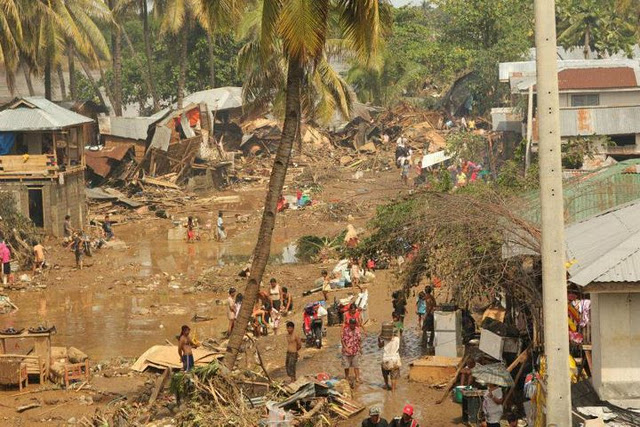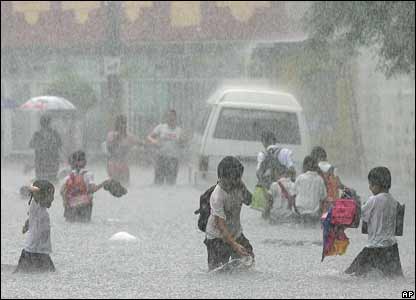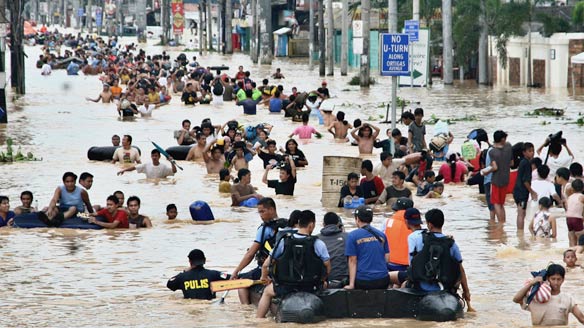Typhoon Sendong: An Avoidable Tragedy
With the death toll recently going over 1000 deaths, the number of human lives ended by Typhoon Sendong is heartbreaking. What makes it more tragic, however, is the fact that many of these deaths could have been avoided.
It is good to see that the government is doing its job of helping the survivors of the calamity in the cities of Cagayan de Oro (CDO) and Iligan. (You too can help the survivors. Start by clicking here.) However, it would have been better to see the government preventing a calamity of this magnitude from happening in the first place. As the saying goes, an ounce of prevention is worth a pound of cure. The prevention would have been as simple as making decisions that were scientifically informed. As this report shows, scientists have already warned both local and national government of this calamity. By not heeding the scientists’ warnings, some government officials are guilty of indirectly causing the tragedy in CDO.

Scientific Literacy in the Philippines
We live in an era when human life should be most enjoyable. For what else is all our scientific knowledge if it is not used to make everyone alive live a long, safe, happy, and healthy life?
We at Filipino Freethinkers believe that the principal purpose of modern science is the improvement of the human condition. This is why we do our best to defend science, combat pseudoscience, and further the cause of science education in this country. (To see the most recent example, read the excellent article Of Heroes and Hoaxes: Painting a CNN Hero in a Dangerous Light).
But defending science and advocating its consistent application in all aspects of life is difficult here in the Philippines. For one, many of the powers that be apparently have a stake in the public’s scientific illiteracy. A good example of this is the CBCP’s opposition against the passage of the RH Bill. The proliferation of many pseudoscientific objections to the bill is another sign that the cause of scientific education here in the Philippines still has a long way to go.
To say that our public is scientifically illiterate is an understatement. As a case in point, recent reports that many young Filipinos take soda-detergent mix as contraceptives reveal the dismal state of reproductive health education in our country.
That the Philippine public is scientifically illiterate is one disheartening thing. That some of our reputable newspapers publish pseudoscience and baloney is another. However, the fact that our government does not make decisions based on scientifically sound judgment is the most tragic of all. Equally sad is how our government needs wake-up calls like the Typhoon Sendong tragedy to finally listen to scientists. But as a Filipino saying goes, “Aanhin mo ang damo kapag patay na ang kabayo? [What will you do with the fodder if the horse is already dead?]”
How Sineskwela and Grade School Science Could Have Avoided the Tragedy
One sad aspect of the public’s relationship with science is how people find science “nosebleed inducing” and intimidating. Even as I write how science could have helped avoided the Sendong tragedy, I can already feel the expectation that a lot of jargon will be involved in the explanation. Let me dispel this expectation as early as now by reiterating the message of this section’s title: to avoid a tragedy similar to the Sendong tragedy, all we need are lessons from the science-centric children’s TV show Sineskwela and our grade school science teacher. These are the lessons the government should’ve heeded three years ago.
Lesson number one: Do not live within a river’s flood plain because this area is naturally flooded on a regular basis. Many people seem to think that humans can live anywhere they want to. But a smart Grade 6 student should be able to tell you that an area known as a flood plain always surrounds rivers. The flood plain of the river is an area close to it that is regularly flooded during heavy rains. It is therefore imperative for the government to disallow people from buying land and building homes within this area. Both local and national government, however, did nothing to prevent many people from building their houses close to the rivers of Lanao del Norte and Misamis Oriental.

Lesson number two: Excessive logging is bad and more trees in the mountains is good. During heavy rains, the roots of big trees trap a lot of the rainwater. This helps prevent flooding and this is why the government should protect forested mountains from greedy logging and mining companies. However, these very rich companies easily bribe our corrupt government officials. The greedy mining companies are especially active in metal-rich CDO. (Even the very name of Cagayan de Oro tells us how much gold there is under its mountains.) When mining companies dig for metals in the mountains, they must cut the trees. To maximize their profit, these companies often try to escape their responsibility of replanting trees, and the government often allows them to get away with it. But we already know that this leads to the the following equation: bald mountains + heavy rains = flash floods = countless preventable deaths.
[Edit: I have been informed that there are no large-scale mining activities in Misamis Oriental as the previous paragraph suggests. Recent developments also suggest that illegal loggers and the people living in the mountain side are more responsible for the loss of forest cover in the mountains of Misamis Oriental.]

Lesson number three: Global warming is changing our climate. The island of Mindanao used to have the kind of climate that rarely experiences strong typhoons. This is why people living in Mindanao are not traditionally prepared for strong storms unlike people living in typhoon-prone areas. But since global warming is changing the world’s climate, places that are not regularly visited by typhoons, like Mindanao, must expect more typhoons in the years to come.

Lesson number four: Global warming will make “wetter” and more vicious tropical typhoons. Because of global warming, storms will now have more rain than usual. This is why flooding is a greater problem now than it used to be. Another effect of global warming is to make typhoons more unpredictable in terms of strength, speed, and path taken. This is why Sendong attacked CDO with the element of surprise.
Lesson number five: Global warming causes sea levels to rise. Because the planet is getting warmer, the polar ice caps are melting. As these ice sheets melt, they add water to the world’s oceans. This causes the water level in the oceans to rise, increasing the risk of flooding in low-lying areas such as the coastal towns and cities of Misamis Oriental.

Scientific Literacy = Human Lives Saved
The fact that the public and the government ignored the simple science lessons given above shows a dangerous lack of understanding of how the Earth works. If Filipinos understood this, they would have more respect for its power and they would be able to prevent its power from ending so many lives.
Although we grieve for the victims of tragedy caused by Sendong, we must not fail to learn from this event. Both the public and the government can help prevent a similar tragedy by learning more about how the Earth works and how its workings are being altered due to climate change.
Let this tragedy be a painful reminder to the public and the policy makers that in this day and age, making decisions based on a high level of scientific literacy is a matter of life and death.



that is not an open pit mine…
I believe that our education system has a ton of issues.
I remember being taught those things from grades 3 to 6 and throughout high school. Assuming the same things are taught in all schools, that would mean every Filipino who had reached grade 3 should have been aware of that knowledge.
However, being equipped with knowledge is not the same as using that knowledge.
It's the same concept as in jaywalking, everyone knows you shouldn't cross there ("Bawal tumawid, may namatay na dito!") but you still see idiots running through traffic (and in some better days, getting caught).
Maybe it's a Filipino thing to forget about common sense for the sake of temporary convenience.